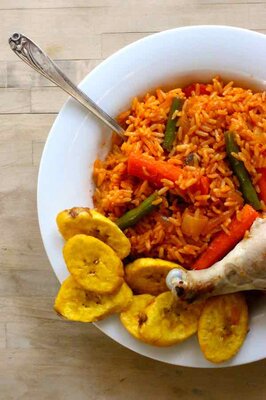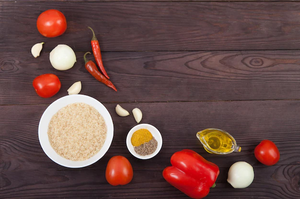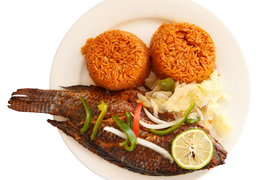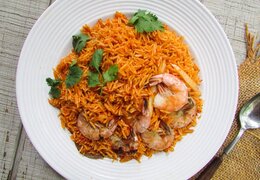It is one of the most common dishes in West Africa.
It is being prepared throughout the region, including Ghana, Nigeria, Senegal, The Gambia, Sierra Leone, Liberia, Côte d'Ivoire, Togo, Cameroon, as well as Mali.
It contains high-quality, red-orange rice, which is cooked with a combination of vegetables, which may include peas, peppers, carrots, cabbage or eggplant, and is often accompanied by meat such as lamb, goat, chicken, beef. Jollof rice is also served with salad, or fried plantain, which is called dodo in Yoruba. This traditional recipe for Jollof rice is called benachin ("one pot" in Wolof language), theibou dienne (or thieboudienne) in Senegal, or the Gambia. and riz au gras in some French-speaking areas.
What is the origin of Jollof rice?
Based on the name of Jollof rice, it can be easily concluded that its origin can be traced to the region of Senegambiu, which was once ruled by the Jolof Empire (1350 to 1549). The Jolof Empire (also Djolof, Wolof), which controlled parts of Senegal and the Gambia, was established as a vassal of the Mali Empire. At that time, the region stretching from the Gambia River to Liberia was also known as the Cereal or Rice Coast, as many cereals, including rice and millet, were grown on the banks of the Senegal River.
However, in his book Stirring the Pot, James McCann argues that Jollof rice may have spread throughout West Africa with the Djula people, merchants from the Mali Empire, historically known as Manden Kurufaba, or just Manden (c. 1230 to 1670). The Senegalese version of this traditional dish, thieboudienne, seems to have originated much later in the nineteenth century.
Interestingly, the main ingredient in the traditional Jollof rice recipe comes from only a small part of West Africa, from Senegal to Sierra Leone. However, another major ingredient in Jollof rice, tomatoes, did arrive from the New World Stock Exchange (exchange) in the fifteenth and sixteenth centuries. This stock exchange was a widespread way of exchange between the New World (America) and the Old World (Afro-Eurasia) in the Eastern Hemisphere. At that time, a Portuguese trading port was established on the Senegal River, where goods and services were exchanged. It is therefore possible that locally grown rice has been combined with imported ingredients such as New World tomatoes to give birth to Jollof rice.
In fact, Jollof rice probably also traveled to America, because jambalaya and especially red rice from small countries have many similarities to Jollof rice. This West African dish will also be reminiscent of the popular Old World paella, as well as many other rice dishes such as galinhada, arroz con pollo, nasi goreng, plov, biryani, majboos, al kabsa, or skoudehkaris.
Who makes the best Jollof rice?

Although Senegal, Gambia, or Mali could easily claim the paternity of this West African main course, there is certainly a carefree war between Nigeria and Ghana over who can cook the best Jollof rice!
Nigerians usually pre-cook Jollof rice. You can also buy pre-cooked rice in a shop (eg Uncle Ben's), or pre-cook in a large amount of water and then add all the other ingredients. Alternatively, they make a separate stew, then mix the rice with the stew to finish cooking together. In Nigeria, Jollof often cooks outside in an iron pot on firewood or charcoal. This version is called Party Jollof Rice and is characterized by a specific smoky flavor, which is obtained by evaporating the water to the point where the rice is almost burned or burnt.
In Ghana, Jollof rice tends to be spicy because it is often served with shito, hot pepper sauce, as well as hard-boiled eggs. Ghanaians tend to use aromatic rice such as jasmine or basmati.
Senegalese Jollof rice is traditionally prepared in one pot, as everything is cooked together slowly so that the rice absorbs the flavors throughout the process.
As in Liberia, the Senegalese version is often served with fish.
Which rice to use to make the perfect Jollof rice?
No matter which rice you decide to use, it is important to pre-cook it. You can use it already pre-cooked, use basmati or jasmine rice. To pre-cook, just cook the rice for 5 to 10 minutes in a large amount of salted water. Rice contains two types of starches called amylose and amylopectin. The ratio of these starches in the rice grain determines the texture of the rice during cooking, as heat and liquid penetrate the grain and the starch molecules decompose.
Amylose is a long, straight starch molecule. Rice grains with a high content of this molecule, such as basmati or jasmine rice, are fluffy and easily separated after cooking. These rice varieties usually have a volume of 22% amylose.
Amylopectin is a highly branched starch molecule. Rice with a higher content of this molecule, such as short-grain rice (risotto rice), medium-grain sushi rice (Calrose rice) or sticky rice, tends to be sticky. These rice varieties usually have a ratio of 15-17% amylose. This explains why basmati or jasmine rice is preferred for rice dishes such as Jollof rice. Persian food polo or Indian biryani are preferred short-grain and medium-grain rice for paella or risotto.





Commets 0
Add a comment